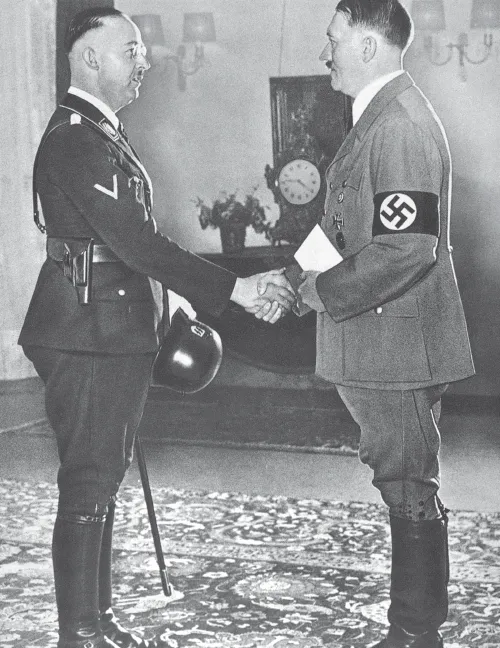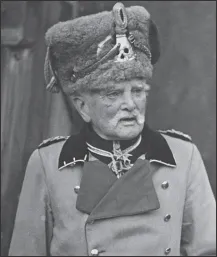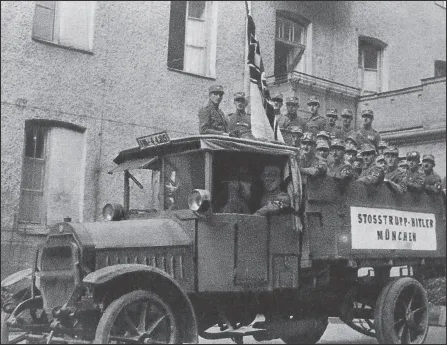![]()
The Reichsführer-SS and his Führer shake hands. Heinrich Himmler’s SS empire contained the concentration camp system and the Waffen-SS, the two key institutions in Totenkopf’s history.
![]()
CHAPTER ONE
FOUNDATION
The Totenkopf Division inspired awe in every unit that faced it. The product largely of one man’s vision, the division epitomised the best and worst aspects of the Waffen-SS, capable of extreme bravery and courage, but also some of the worst atrocities of the war.
The Waffen-SS earned a fearsome combat reputation in World War II. By May 1945, more than 800,000 men had served in its 38 divisions and some 20–25 per cent of them had been killed in battle. Waffen-SS formations fought on all fronts except the Western Desert and, in particular, played a critical role on the Eastern Front in the war against the Soviet Union. Yet despite the Waffen-SS’s high standing within the German armed forces, the Wehrmacht, this reputation largely rested on a half dozen or so first-class fighting formations. The 3rd SS Panzer Division Totenkopf was part of this inner core of elite SS formations. The Totenkopf, or Death’s Head, Division saw service in France in 1940. It also took part in Operation Barbarossa, the invasion of the Soviet Union in 1941, and thereafter was involved in some of the bitterest fighting on the Eastern Front: at Demyansk, at Kursk, outside Warsaw and, towards the end of the war, around Budapest. The division fought with bravery and tenacity throughout the conflict, and Hitler and many senior Wehrmacht commanders, such as Erich von Manstein, considered the Totenkopf Division one of Nazi Germany’s best and most reliable fighting formations.
Totenkopf’s ferocity and ability to endure in battle were legendary. The men of the division were manifestly not Soldaten wie die anderen auch (‘just soldiers like the others’), as postwar German chancellor Konrad Adenauer is reputed to have described the members of the Waffen-SS in 1953. The division’s background, the personality of its founder Theodor Eicke and the traditions, motivation and ideology of the Waffen-SS meant that Totenkopf was not just another military formation. As Robert Koehl noted in his book The Black Corps: ‘Tradition, that familiar concept in military annals, had its influence in the SS too, and not always as desired by SS commanders – or by SS volunteers – forcing the man to become both more than himself, and a good deal less.’
The unit’s formidable combat reputation rested on a ruthless and brutal criminality when it came to the treatment of enemy prisoners-of-war or civilians. It is worth noting that five of the most well-known and well-documented atrocities committed by the Waffen-SS – the massacres of Le Paradis, Tulle, Oradour-sur-Glane, Malmedy and the reprisal killings on the Arno – were either carried out by Totenkopf units or were associated with men who were products of the Totenkopf Division. This is quite apart from the division’s intimate involvement in the SS-run concentration camp system.
![]()
Adolf Hitler (on right of picture) with two comrades from World War I, Ernst Schmidt and Max Amann. Hitler found a sense of purpose in his military service, and was embittered by Germany’s defeat.
![]()
The Waffen-SS produced men such as Fritz Knöchlein, Heinz Lammerding, Hermann Preiss and Max Simon. Fritz Knöchlein commanded the 14th Company of Totenkopf’s 2nd Battalion at Le Paradis; Heinz Lammerding was the ex-operations officer of the Totenkopf Division who, as commander of the 2nd SS Division Das Reich, ordered the massacres of French civilians at Tulle and Oradour; Hermann Preiss, SS-Gruppenführer (Major General) and briefly divisional commander of Totenkopf, was prosecuted for the massacre of US troops at Malmedy, Belgium, by troops of his then command, 1st SS Panzer Division Leibstandarte Adolf Hitler; and Max Simon, long-term stalwart of the Death’s Head Division, ordered the reprisal killings at Arno. To understand the environment which created such men, it is worth examining the origins of the Nazi Party, the SS, the Waffen-SS and the concentration camp system.
THE ORIGINS OF THE SS
As a soldier in the Bavarian Reserve Infantry Regiment 16 in World War I, Adolf Hitler found a sense of comradeship, discipline and a cause for the first time in his life. On 11 November 1918, the war ended while Hitler was convalescing in hospital in Pomerania, after being gassed in Belgium. He was horrified by the news of defeat and recalled from his hospital bed that he now ‘knew everything was lost. Only fools – liars or criminals – could hope for mercy from the enemy. In these nights my hatred grew against the men who had brought about this crime.’
The return to civilian life was impossibly difficult for numerous veterans of World War I. Many were surprised by the suddenness of Germany’s collapse and, like Hitler, felt that their country’s civilian leadership had betrayed them. They also returned home to political chaos, hunger and revolution, as extremist groups tried to seize power. Plenty of ex-German soldiers had no desire to return to disdain, unemployment and even possible starvation. These men proved ready recruits for the Freikorps, the paramilitary force used by the embattled new German Government to suppress the attempted communist takeover of early 1919 and Polish insurgents on Germany’s now much-reduced eastern border. The political outlook of the Freikorps was largely nationalistic and right wing, and members often drifted into membership of one of the many parties that had grown up on Germany’s extremist fringe.
One of those parties was the Deutsche Arbeiter Partie (DAP – German Workers’ Party). Adolf Hitler was still on the payroll of his wartime regiment and was sent to report on the DAP’s activities. He joined the party in September 1919, and such were his abilities that he rose quickly to propaganda director. Hitler subsequently had the party renamed the Nationalsozialistische Deutsche Arbeiter Partie (NSDAP – National Socialist German Workers’ Party, usually shortened to Nazi Party from NAtional and so-ZI-alist). Hitler’s rise was rapid and, by January 1922, he had manoeuvred his way into the chairmanship of the party.
![]()
A product of the Prussian elite: General von Mackensen, seen here in 1940, has duelling scars visible on his cheeks. Note the death’s head symbol, later adopted by Totenkopf, worn on his headgear.
![]()
NSDAP political meetings in the early 1920s often degenerated into running battles with left-wing groups. The NSDAP initially received protection from Zeitfreiwilligen (temporary volunteers) from the Munich Reichswehr (the Reich’s Defence – German armed forces), but these men, while quite possibility sympathetic, were not the kind of devoted party supporters Hitler envisaged. Besides, their primary loyalties lay elsewhere.
Nonetheless, Ernst Röhm, a Reichswehr officer and local Freikorps leader who had liaised with Hitler in his role as informer, was impressed enough with the fledging and still minuscule party to join. Röhm, an experienced soldier and organiser of paramilitary forces, was the driving force behind the more muscular side of the NSDAP, initially known as the Sports and Gymnastic Division (SA). Röhm set about expanding the SA which, in November 1921, gained the new title of Sturmabteilungen, or storm troopers, and handily retained the same initials. The name bore connotations of the elite assault detachments of World War I, something which appealed to the hardened Freikorps veterans who made up most of the SA.
![]()
A famous shot of the Stosstrupp Adolf Hitler ready for action in Bayreuth, 2 September 1923. Hitler’s early bodyguard were a forerunner of the SS. Ulrich Graf stands to the right of the Imperial German flag.
![]()
Hitler soon found, however, that the SA men were not entirely his to command. They were not always available to him, and owed their primary loyalty to Röhm. When Hitler attended their meetings, manoeuvres or drill parades, he was received politely, but was not allowed to control the men. In spite of this, Röhm was quite close to Hitler; he was one of the few amongst Hitler’s close associates who used the familiar du (you) as a term of address. In March 1923, aware of Hitler’s concern, Röhm formed a Munich-based bodyguard of 12 SA men solely to protect the party leader. Hitler’s new bodyguard were known as the Stabswache (Headquarters Guard) and they swore an oath of personal loyalty to him. Yet the Stabswache remained in the SA and the unit was soon disbanded after yet another quarrel with the SA leadership.
Indeed, the SA’s relationship with the party remained unclear. Despite appointing Hermann Göring, a highly decorated hero of World War I and loyal comrade, to organise and command the military wing of the SA, Hitler knew that the organisation remained Röhm’s private army, which refused to take orders from Nazi Party officials. Röhm’s somewhat apolitical attitude was clearly stated in a memo that he sent to Hitler: ‘Party politics will not be tolerated … in the SA.’ Thus it was that, two months after the formation of the Stabswache, Hitler created a carefully selected 100-man force, the Stosstrupp Adolf Hitler, who were, as their name suggested, unquestionably loyal to him. The Stosstrupp were armed, motorised and wore military-style uniforms. By the autumn, they had reached the strength of four platoons: one infantry platoon of four squads, a machine-gun platoon, a machine-pistol platoon and a mortar platoon. They also soon adopted the death’s head (skull-and-cross bones) symbol as their emblem.
The Stosstrupp received their badges from a stock of army surplus equipment and thereby tapped into an image with a long lineage in German military tradition. This distinctive emblem would remain a key symbol of the future SS and was divisional insignia of the 3rd SS Division Totenkopf. Indeed, it was the only badge shared with all SS formations – the Allgemeine-SS (General SS), Germanic-SS and Waffen-SS. Despite its sinister appearance, the death’s head was chosen for its historical resonance rather than from any desire to strike fear into those who saw it. In 1741, the elite Prussian units Leib-Husaren regiments 1 and 2 adopted the symbol in honour of the Prussian king, Freidrich Wilhelm I, who had died the previous year. The German state of Brunswick also used the symbol for Hussar Regiment 17 and the 3rd Battalion of Infantry 92 during the Napoleonic Wars. The death’s head emblem remained in use throughout Germany’s unification and, during World War I, was chosen as a badge by a number of crack German formations such as storm troopers and tank men. It was also adopted by some of the more fearsome Freikorps units in the immediate postwar years. As Robin Lumsden notes in his description of SS symbolism in SS Himmler’s Black Order 1923–45: ‘Because of its association with these formations it became symbolic not only of wartime daring and self-sacrifice, but also of post war traditionalism, anti-liberalism and anti-Bolshevism.’ It was an appropriate choice for the Stosstrupp and its successor, the SS.
The Stosstrupp was soon in action. Hitler, in one of the few serious misjudgments of his interwar political career, decided to take advantage of the volati...




